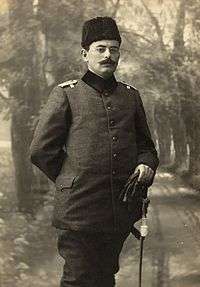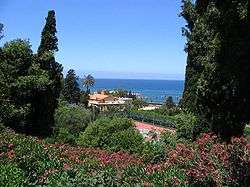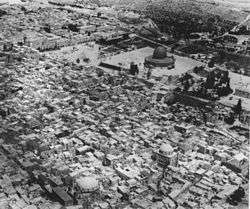Tawfiq Canaan
Tawfiq Canaan (Arabic: توفيق كنعان) (24 September 1882 – 15 January 1964) was a pioneering Palestinian physician, medical researcher, ethnographer, and Palestinian nationalist. Born in Beit Jala during the rule of the Ottoman Empire, he served as a medical officer in the Ottoman army during World War I.[1] During British rule, he served as the first President of the Palestine Arab Medical Association founded in 1944, and as the director of several Jerusalem area hospitals before, during, and after the 1948 war. Over the course of his medical career, he authored more than thirty-seven studies on topics including tropical medicine, bacteriology, malaria, tuberculosis, and health conditions in Palestine, and contributed to research that led to a cure for leprosy.[2][3]
Tawfiq Canaan | |
|---|---|
 | |
| Born | 24 September 1882 |
| Died | 15 January 1964 (aged 81) |
| Nationality | Palestinian |
| Occupation | Physician, Ethnographer, author |
| Known for | Pioneer in the field of medicine in Palestine Researcher of Palestinian popular heritage |
| Parent(s) | Bechara Canaan and Katharina Khairallah |
Deeply interested in Palestinian folklore, popular beliefs, and superstitions, Canaan collected over 1,400 amulets and talismanic objects held to have healing and protective properties. His published analyses of these objects, and other popular folk traditions and practices, brought him recognition as an ethnographer and anthropologist.[4][5][6] The several books and more than 50 articles he wrote in English and German serve as valuable resources to researchers of Palestinian and Middle-Eastern heritage.[2][4]
An outspoken public figure, he also wrote two books on the Palestine problem, reflecting his involvement in confronting British imperialism and Zionism.[2][7] He was arrested by the British authorities in 1939. The last two decades of his life were lived in the shadow of several personal tragedies: the loss of his brilliant son in an accident at Jerash, the loss and destruction of his family home, and of his clinic in Jerusalem during the 1948 war.[8]
Canaan managed to re-establish his life and career in East Jerusalem under Jordanian rule. First taking sanctuary in a convent in the Old City for two years, he was appointed director of the Augusta Victoria Hospital on the Mount of Olives, where he lived with his family through his retirement until his death in 1964.[9]
Early life

Born in the village of Beit Jala in Palestine during the rule of the Ottoman Empire, Canaan studied as a child at the Schneller School, founded by German missionaries in nearby Jerusalem. His father Bechara, who was also schooled there, founded the first Lutheran church, YMCA, and co-ed school in Beit Jala and the first Arab pastor for the German Protestant Palestine Mission.[10][11] His mother, Katharina, was raised in a German orphanage in Beirut and met Bechara while working at a hospital in Jerusalem.[12]
In 1898-9, Canaan went to Beirut to study medicine at the Syrian Protestant College (today the American University of Beirut). Obliged to work while studying as his father died of pneumonia shortly after his arrival, he graduated with distinction in 1905.[13][12] His valedictory speech, "Modern Treatment", was likely his first published piece and broached the use of serums, animal organs, and X-rays.[14]
Canaan attributed his love of, interest in, and dedication to the people, culture and land of Palestine to his upbringing and the influence of his father who regularly took the family with him on his trips around the country.[15] In the Jerusalem Quarterly, Khaled Nashef suggests Canaan's knowledge of nature in Palestine as exhibited in writings such as "Plant-lore in Palestinian Superstition" (1928) among others were informed by these trips.[13]
Medical career

Returning to Jerusalem from Beirut, Canaan began work in the German Deaconnesses Hospital, co-administering it with Dr. Adalbert Einsler (1848–1919) during a senior physician’s absence in 1906.[12][16] He was also sought as a manager at the German-Jewish Hospital (Shaare Zedek). His first published medical article as a practicing physician, “Cerebro-Spinal Meningitis in Jerusalem" (1911), was based on studies he conducted with the director there.[14]
Between 1912-1914, Canaan travelled to Germany several times to further his knowledge of microbiology and tropical diseases. On his first trip there, he met Margot Eilender, the daughter of a German importer, who had herself been born and raised in the Middle East, and they were quickly married, having their first child Yasma that same year. They built their family home in the al-Musrarah district of Jerusalem in 1913, where their three other children (Theo, Nada, and Leila) were born. In that home, Canaan also opened the only Arab clinic operating in Jerusalem at the time.[17][1]
One of the physicians Canaan collaborated with in Germany was Hans Müch, head of a mission to Palestine whose 1913 report on tuberculosis included three research papers authored by Canaan.[18] That same year, he was appointed director of the Malaria Branch of the International Health Bureau, a world center for medical research and microscopic examination founded by The German Society for Fighting Malaria, The Jewish Health Bureau, and The Jewish Physicians and Scientists for Improving Health in Palestine.[19]
Published works
(Partial list)
Folklore and ethnography
- "Agriculture in Palestine". Globus (in German). 1909.[14]
- "Demons as an Aetiological Factor in Popular Medicine". Al-Kulliyeh. Beirut. 1912.
- "The Calendar of Palestinian Peasants". Zeitschrift des Deutschen Palästina-Vereins (in German). 1913.[18]
- Superstition and Popular Medicine. 1914. ISBN 1-871034-01-9.[18]
- Canaan, Tawfiq (1921). "Haunted Springs and Water Demons in Palestine". The Journal of the Palestine Oriental Society. Jerusalem: The Palestine Oriental Society. 1: 153–170.
- Alternative: Haunted Springs and Water Demons in Palestine. Jerusalem: Palestine Oriental Society. 1922. OCLC 187062829.[20] See also Jumana Emil Abboud
- Canaan, Tawfiq (1922). "Byzantine Caravan Routes in the Negev". The Journal of the Palestine Oriental Society. Jerusalem: The Palestine Oriental Society. 2: 139–144.
- Tasit ar-Radjfeh ("Fear Cup") (in Arabic). 1923.[20]
- Canaan, Tawfiq (1927). Mohammedan Saints and Sanctuaries in Palestine. London: Luzac & Co.[21]
- Alt:Canaan, Tawfiq (1927). Mohammedan Saints and Sanctuaries in Palestine. London: Luzac & Co.
- Plant-lore in Palestinian Superstition. 1928.[20]
- Belief in Demons in the Holy Land (in German). 1929.[20]
- Studies in the Topography and Folklore of Petra. 1929.[22]
- "Light and Darkness in Palestine Folklore". Journal of the Palestine Oriental Society (JPOS). 1931.[21]
- "Unwritten Laws Affecting the Arab Women of Palestine" (PDF). Journal of the Palestine Oriental Society (JPOS). 1931. Archived from the original on 2 October 2011.CS1 maint: BOT: original-url status unknown (link)
- The Palestine Arab House: Its Architecture and Folklore. Jerusalem: The Syrian Orphanage Press. 1933.[21]
- "Arabic Magic Bowls". Journal of the Palestine Oriental Society. 1936.[23]
- "Review of Dalman's Arbeit und Sitte in Palästina". Journal of the Palestine Oriental Society (JPOS). 1934.[21]
- "Review of Granquist's Marriage Conditions in a Palestinian Village". Journal of the Palestine Oriental Society (JPOS). 1933 and 1937. Check date values in:
|year=(help)[21] - "The Decipherment of Arabic Talismans". Berytus Archaeological Studies. 4: 69–110. 1937.[24]
- "The Decipherment of Arabic Talismans". Berytus Archaeological Studies. 5: 141–151. 1938.[24]
- Canaan, T (October 1962). "Superstition and Folklore about Bread". Bulletin of the American Schools of Oriental Research. The American Schools of Oriental Research (167): 36–47. ISSN 0003-097X. JSTOR 1355686.
- "The 'Azazime Bedouin and Their Region". Arab World Geographer. 2 (4). Winter 1999. (translated from German by William Templer)
Politics
Medical
- "Modern Treatment". Al-Muqtataf. Beirut. 1905.[13]
- "Cerebro-Spinal Meningitis in Jerusalem". Al-Kulliyeh. Beirut. 1911.[18]
- "Beobachtungen bei einer Denguefieberepidemie in Jerusalem ("Observations on an epidemic of dengue fever in Jerusalem")". Archiv für Schiff- und Tropenhygiene (in German). 17: 20–25. 1912.[26]
- "Die Jerichobeule". Archiv für Schiff- und Tropenhygiene (in German). 20: 109–119. 1916.[27]
- Canaan, T (1929). "The Oriental Boil: An Epidemiological Study in Palestine". Transactions of the Royal Society of Tropical Medicine and Hygiene. 23: 89–94. doi:10.1016/S0035-9203(29)90903-2.[28]
- "Zur Epidemiologie der Orientbeule in Palästina". Dermatologische Wochenschrift (in German). 29 (91): 1779. 1930.
- "Kalazar in Palestine". Festschrift Bernhard Nocht (in German). 80: 67–71. 1937.
- "Topographical studies in leishmaniasis in Palestine". Journal of the Palestinian Arab Medical Association. 1: 4–12. 1945.[29]
- "Intestinal parasites in Palestine". J. Med. Liban. 4 (3): 163–69.[30]
Awards
- Order of the Red Crescent (in World War I[31]
- Iron Cross of 1914[31]
- Holy Sepulchre Cross with a red ribbon, awarded by the Greek Orthodox Patriarch (1951)[31]
- Order of Merit of the Federal Republic of Germany (1951)[31]
References
- Mershner, 2006, p. 252.
- Nashef, 2002, p. 2.
- El-Eini, 2006, p. 88.
- Jubeh, Fall-Winter 2005, p. 103.
- Davis, 2004.
- Benvenisti, 2000, p. 252.
- Bernstein, 2000, p. 123.
- W.F. Albright, 'In Memoriam,' Bulletin of the American Schools of Oriental Research, No. 174 (Apr., 1964), pp. 1-3,p.3.
- Nashef, 2002, p. 14.
- Abdullah, June 2000.
- Lapp and Albright, 1964, pp. 1−3.
- Mershner, 2006, p. 251.
- Nashef, 2002, p. 3.
- Nashef, 2002, p. 4.
- Nashef, 2002, p. 3. "We used to go with my father on short and long trips all over the country in order to get acquainted with the country and the people. This continuous contact with the people nurtured in all of us, and particularly in me, love for the country and the people. This feeling of belonging and unshaken loyalty remained with me till this day."
- Eisler and Frutiger, 2008, p. 334.
- Nashef, 2002, p. 8.
- Nashef, 2002, p. 5.
- Nashef, 2002, p. 9.
- Nashef, 2002, p. 6.
- Tamari, 2009, p. 202.
- Taylor, 2001, p. 217.
- Richards, D. S. (2002). The Annals of the Saljuq Turks: Selections from Al-Kāmil Fīʻl-Taʻrīkh of ʻIzz Al-Dīn Ibn Al-Athīr. New York: Routledge. ISBN 0-7007-1576-2.
- Schaefer, Karl R. (2006). Enigmatic charms: medieval Arabic block printed amulets in American and European libraries and museums. Leiden: Brill. p. 239. ISBN 90-04-14789-6.
- Nashef, 2002, p. 10.
- Liverpool School of Tropical Medicine, 1912, p. 410.
- Hygienische Rundschau, 1917, p. 225.
- "The Oriental Boil:An Epidemiological Study in Palestine". Tropical Medicine and Hygiene. Elsevier. 23 (1): 89–94. 25 June 1929.
- Patai, 1957, p. 152.
- Aall-Zyukov, 1932, p. 1011.
- Nashef, 2002, p. 15.
Bibliography
- Abdullah, Wissam (June 2000). "Special Feature: The Tawfik Canaan Collection of Palestinian Amulets – Birzeit University". This Week in Palestine (26).
- Benvenisti, Meron (2000). Sacred Landscape: The Buried History of the Holy Land since 1948. Berkeley: University of California Press. p. 253. ISBN 0-520-21154-5.
.
- Bernstein, Deborah S. (2000). Constructing Boundaries: Jewish and Arab Workers in Mandatory Palestine. Albany: SUNY Press. ISBN 0-7914-4539-9.
- Davis, Rochelle (January 2004). "Peasant Narratives Memorial Book Sources for Jerusalem Village History". Jerusalem Quarterly (20). Archived from the original on 28 September 2007. Retrieved 4 August 2009.
- El-Eini, Roza (2006). Mandated Landscape: British Imperial Rule in Palestine (1929–1948). New York: Routledge. ISBN 0-7146-5426-4.
- Eisler, Ejal Jakob (איל יעקב איזלר); Frutiger, Hans Hermann (2008). Johannes Frutiger (1836–1899): ein Schweizer Bankier in Jerusalem (in German). Cologne et al: Böhlau. ISBN 978-3-412-20133-3.
- Baha' al-Ju'beh (Fall–Winter 2005). "Magic and Talismans: The Tawfiq Canaan Collection of Palestinian Amulets" (PDF). Jerusalem Quarterly (22–23): 103. Retrieved 21 July 2009.
- Lapp, Paul W.; Albright, W. F. (April 1964). "Tawfiq Canaan in Memoriam". Bulletin of the American Schools of Oriental Research. The American Schools of Oriental Research (174): 1–3. JSTOR 1356065.
- Mershen, Birgit (2006). Huebner Ulrich (ed.). "Tawfiq Canaan and His Contribution to the Ethnography of Palestine". Palaestina exploranda : Studien zur Erforschung Palästinas im 19. Und 20. Jahrhundert anlässlich des 125jährigen Bestehens des Deutschen Vereins zur Erforschung Palästinas: 251–264.
- Nashef, Khaled (November 2002). "Tawfik Canaan: His Life and Works" (PDF). Jerusalem Quarterly (16). Retrieved 21 July 2009.
- Patai, Raphael (1957). Jordan, Lebanon, and Syria: an annotated bibliography. New Haven: HRAF Press. OCLC 174331967.
- Raheb, Mitri (1990). "Das reformatorische Erbe unter den Palästinensern". Zur Entstehung der Evangelisch-lutherischen Kirche in Jordanien (= die Lutherische Kirche, Geschichte und Gestalten) (in German). Gütersloh: Mohn. 11: 91–96. ISBN 3-579-00127-2. Originally presented in 1988 as author's thesis (doctoral) at Fachbereich Evangelische Theologie of Philipps-Universität in Marburg
- Sperling, Arthur (1917). Hygienische Morgentoilette: Gymnastik und Selbstmassage für Gesunde und Kranke (in German). 27. Munich: Verlag der Ärztlichen Rundschau Otto Gmelin. OCLC 218409429.
- Sufian, Sandra Marlene (2007). Healing the land and the nation: malaria and the Zionist project in Palestine, 1920–1947 (Illustrated ed.). University of Chicago Press. ISBN 978-0-226-77935-5.
- Tamari, Salim (2009). "Lepers, Lunatics and Saints: The Nativist Ethnography of Tawfiq Canaan and his Jerusalem Circle". Mountain Against the Sea. Berkeley: University of California Press. ISBN 978-0-520-25129-8.
- Taylor, Jane (2001). Petra and the Lost Kingdom of the Nabataeans. London: I.B.Tauris. ISBN 1-86064-508-9.
- Taylor, Joan E. (1993). Christians and the holy places: the myth of Jewish-Christian origins (Illustrated ed.). Oxford University Press. ISBN 978-0-19-814785-5.
- Taylor, Joan E. (2003). Jewish Women Philosophers of First Century Alexandria. Oxford: Oxford University Press. ISBN 0-19-929141-1.
- U.S. Agricultural Research Service (1932). Charles Wardell Stiles (ed.). Index-catalogue of medical and veterinary zoology. Washington, D.C.: U.S. Government Printing Office.
- Yellow Fever Bureau, Liverpool School of Tropical Medicine (1912). Bulletin. 2. Liverpool: University Press. OCLC 1640456.
External links
- The Tawfiq Canaan Collection of Palestinian Amulets – A virtual gallery
- The Great War in Palestine: Dr Tawfiq Canaan’s Photographic Album, Norbert Schwake, 2014, Jerusalem Quarterly, Institute for Palestine Studies